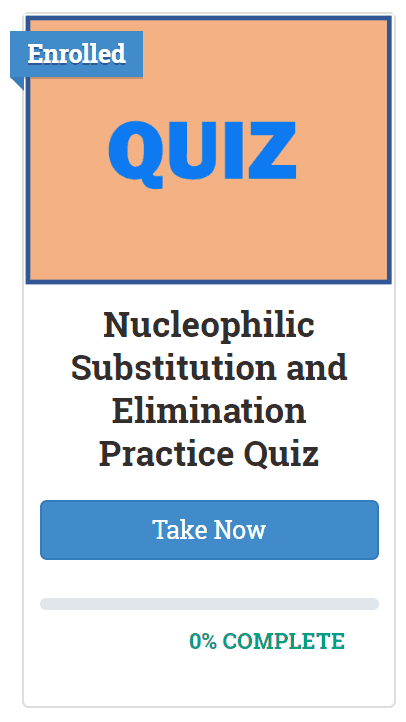In this practice problem, you will need to determine the major organic product and the mechanism of each reaction.
This covers the competition between SN1, SN2 nucleophilic substitution, and E1/E2 elimination reactions.
You can check this post (SN1 SN2 E1 E2 – How to Choose the Mechanism) before working on the problems.
To correctly answer these questions, you need to review the main principles of substitution reactions and elimination reactions, as well as the regio- and stereochemistry of the above-mentioned reactions, depending on whether the given reaction goes via a unimolecular or bimolecular mechanism, which dictates, for example, the possibility of rearrangement reactions. You can also go over the stereoselectivity and stereospecificity of the E2 and E1 reactions. The reactivity of the substrate (alkyl halide), the effect of the solvent, and temperature should also be taken into consideration.
SN1, SN2, E1, E2 Flow Chart
📥 Download this study guide and refer to page 3 as a reference to determine the correct mechanism. You can download the complete set of the study guides at https://www.chemistrysteps.com/cs-benefits/
🗺️ All the Reactions of Alkyl Halides Connected in a Comprehensive Reaction Map
This content is for registered users only.
By joining Chemistry Steps, you will gain instant access to the answers and solutions for all the Practice Problems, including over 40 hours of problem-solving videos, Multiple-Choice Quizzes, Puzzles, Reaction Maps, and the powerful set of Organic Chemistry 1 and 2 Summary Study Guides.






For practice question B, why would the product be 2 chloro pentane not 2 pentanol?
Indeed, it is an alcohol, Justine. Good catch.
For W, how do you address the R and S if there is a plane of symmetry?
You still need to show the stereochemistry.
in question o), should it undergo a carbocation rearrangement first. The carbocation will move one spot to the left, which is a secondary position plus resonance stabilization from the benzene ring. But in your solution, there is no carbocation rearrangement. Am I mistaken?
Following my mechanism, then it will get attacked by the MeOH, which will form race mixture of 2 stereoisomers.
Great question! Although not every carbocation will go via rearrangement, it is a good habit to keep rearrangements in mind. I assume this is how you see it; the driving force for the hydride shift here would have been the resulting tertiary carbocation.
However, a few important things to be careful about here. First, there is no hydrogen on the carbon in the ring connected to the methyl group.
And even if there was one, it wouldn’t shift in this case, since the resulting tertiary carbocation would come at the price of breaking the aromaticity. Aromatic compounds have additional stability and breaking the double bonds in the ring is energetically not favorable. Moving that hydrogen would make a phenyl carbocation which, unlike benzylic carbocations, is very unstable since there is no resonance stabilization of the positive charge. The orbital alignments do not allow forming a conjugated system.
Check the following articles for additional information about aromatic compounds:
• Benzene – Aromatic Structure and Stability
• Aromaticity and Huckel’s Rule•
Reactions at the Benzylic Position
Thanks for your comment. Now I see it. The reason why I made the mistake is my own carelessness: I thought there are 2 carbons in the “tail”. But really, there is only one carbon in the tail. When the carbocation formed, it is primary BUT stabilized by benzene ring.
That is correct-without any stabilization, primary carbocations are usually be formed to undergo any reaction. One exception that comes to mind is the diazonium salts that can lose nitrogen and form primary carbocations.
The Reaction of Amines with Nitrous Acid
Where does the second ring come in from in Y?
Hi,
Remember, we carry out reactions on molar (whether that is milli-, micro- or nanomolar) scale and therefore, at any time, there is millions of reactant molecule present in the mixture. And even though, there might be shown only one molecule of a reactant, you should always keep in mind the possibility of an intramolecular reaction.
I have added the mechanism too.
For question f, can someone help me understand the major mechanism? My understanding is that water is a stronger Nu than it is a base, thus it will undergo SN1. However, I’m not sure my interpretation is correct.
Hi there,
Water is a weak base and a poor nucleophile and therefore, the mechanism should be a unimolecular SN1 or E1. In most cases, the determining factor between these is going to be the heat which favors elimination. I talked about the effect of heat in this article: https://chemistrysteps.com/the-e1-mechanism/
Check also the article on deciding between SN1, SN2, E1 and E2: https://chemistrysteps.com/sn1-sn2-e1-e2-choose-which-mechanism/
Don’t forget to download the substitution and elimination study guide at https://chemistrysteps.com/cs-benefits/.
hi! for question (I) could it possible for it to be Sn1/E1 as well? since there could be a rearrangement of carbocations. is it not because it’s a strong nucleophile?
Hi there!
Just to clarify, is the question about the reaction of the alcohol with HBr or (bromomethyl)cyclopentane with the acetylide (triple bond anion)? Question l or i?
oh the (i) please
Yes, then you are correct – it is because acetylide ions are good nucleophiles and strong bases. You can find the list of good/poor nucleophiles, and strong/weak bases in the substitution and elimination study guide. The study guides are available to download here.
okayy thank you!